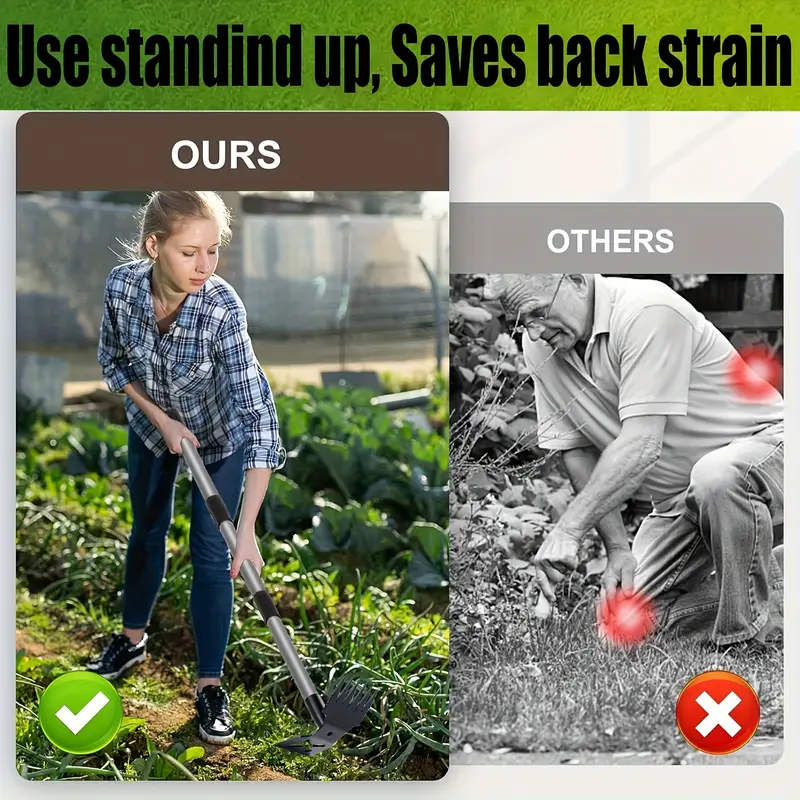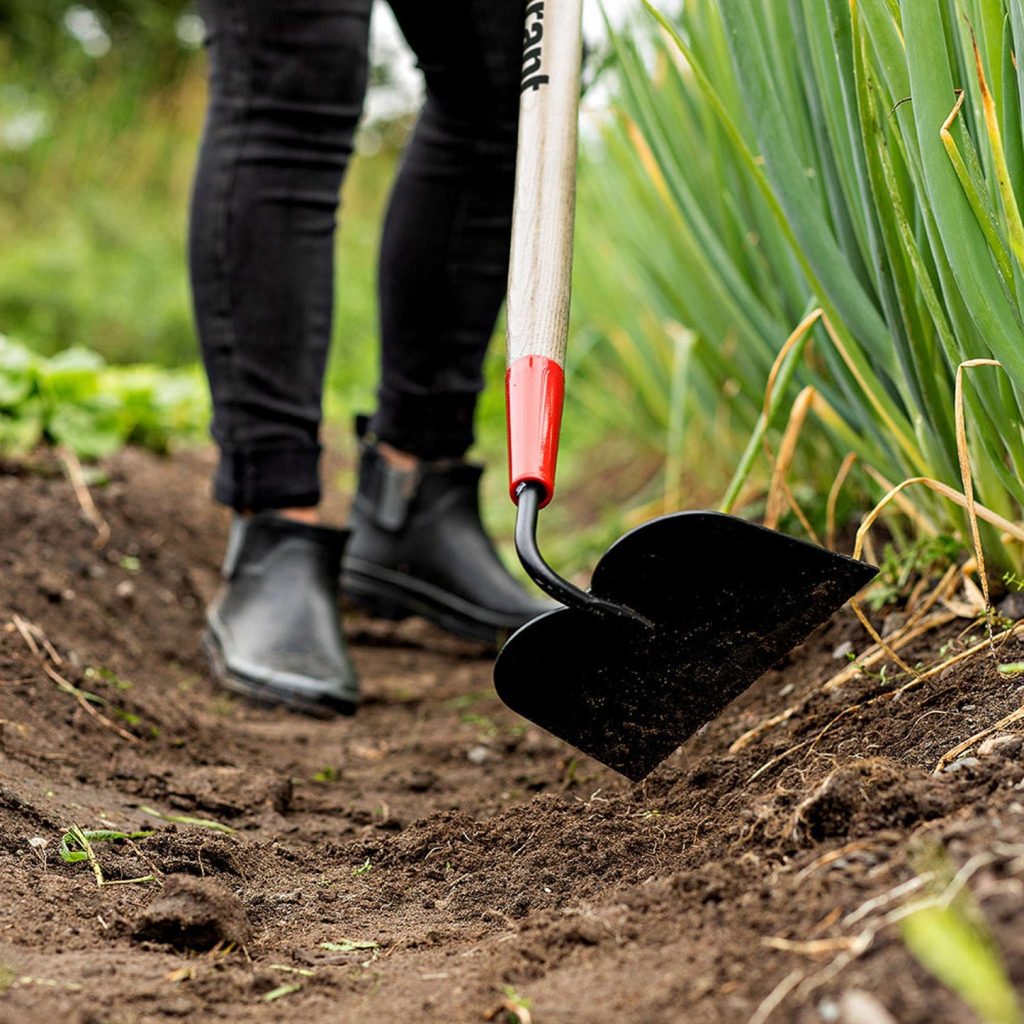Are you ready to make your garden work easier and more enjoyable? Using a garden hoe is one of the simplest ways to keep your plants healthy and your soil in top shape.
But if you’re not sure how to use it correctly, you might be missing out on a powerful tool that can save you time and effort. You’ll discover step-by-step how to use a garden hoe like a pro, so your garden can thrive and you can enjoy every moment spent outdoors.
Keep reading, and your garden will thank you!
Choosing The Right Garden Hoe
Using a garden hoe can make your work easier and your garden healthier. Picking the right hoe helps you weed, dig, and shape soil better.
Knowing the types, materials, and garden size will guide you to the best hoe choice for your needs.
Types Of Garden Hoes
There are many kinds of hoes for different tasks. Each type works best in certain garden jobs.
- Draw Hoe:Has a flat blade for chopping and digging.
- Stirrup Hoe:Features a looped blade that cuts weeds just below the surface.
- Collinear Hoe:Thin blade good for slicing weeds in tight rows.
- Warren Hoe:Triangular blade useful for digging and shaping soil.
- Dutch Hoe:Sharp blade that cuts weeds when pushed forward.
Materials And Durability
Garden hoes come in various materials. Some last longer and feel stronger in your hands.
| Material | Durability | Weight | Cost |
| Steel | High | Medium | Moderate |
| Carbon Steel | Very High | Medium | Higher |
| Aluminum | Medium | Light | Moderate |
| Wood (Handle) | Medium | Medium | Low |
Selecting Based On Garden Size
The size of your garden affects the hoe you should pick. Different sizes help you work faster or get into small spaces.
- Small Gardens:Use a short-handled hoe for control and easy movement.
- Medium Gardens:A standard hoe with a medium handle fits most tasks.
- Large Gardens:Long-handled hoes reduce bending and speed up work.

Credit: www.temu.com
Preparing For Hoeing
Using a garden hoe can make your gardening tasks easier. Proper preparation is key to effective hoeing.
Before you start, ensure you are ready and your tools are in good condition.
Safety Gear And Precautions
Wearing the right safety gear can prevent injuries while hoeing. Always prioritize safety.
- Wear gloves to protect your hands from blisters.
- Use sturdy shoes to protect your feet.
- Wear a hat to shield from sun exposure.
- Ensure your hoe is sharp and in good condition.
Soil Conditions To Check
Checking soil conditions is crucial for effective hoeing. Good soil makes your work easier and more efficient.
Ensure the soil is moist but not too wet. Dry soil is hard to hoe, while overly wet soil can clump and stick to the hoe.
Clearing The Area
Before you begin, clear the area of obstacles. This helps prevent accidents and makes hoeing more effective.
| Obstacle | Action |
| Rocks | Remove or relocate |
| Large sticks | Pick up and clear away |
| Weeds | Pull them out or cut down |
Hoeing Techniques For Beginners
Using a garden hoe helps keep your plants healthy by removing weeds. It also loosens soil for better water flow.
Learning the right way to use a hoe makes gardening easier and safer. Try simple steps before working in your garden.
Proper Grip And Stance
Hold the hoe firmly but not too tight. Use both hands for control and balance.
Stand with your feet shoulder-width apart. Keep knees slightly bent for comfort.
- Place one hand near the top of the handle
- Place the other hand lower down on the handle
- Keep your back straight to avoid strain
- Face the area you want to hoe directly
Basic Hoeing Motions
Use short, gentle strokes to cut weeds just below the soil surface. Avoid digging too deep.
Sweep the hoe in a forward and backward motion. Work in rows or sections for better coverage.
- Keep the hoe blade close to the ground
- Use your arms and shoulders, not your back
- Move slowly and steadily to avoid missing weeds
- Clear debris from the blade often
Avoiding Common Mistakes
Do not hold the hoe too tightly. This can cause hand fatigue and poor control.
Avoid bending your back too much. This can lead to pain and injury.
- Do not hoe too deep; it can harm plant roots
- Do not rush; slow and steady works best
- Do not ignore weeds; remove them early
- Do not forget to clean your hoe after use
Advanced Hoeing Tips
Using a garden hoe well helps keep your plants healthy. Advanced techniques improve your soil and control weeds better.
These tips help you work smarter, not harder. Learn how different hoeing depths and styles affect your garden.
Shallow Vs. Deep Hoeing
Shallow hoeing removes small weeds near the soil surface. It is gentle on plant roots and good for young plants.
Deep hoeing breaks up hard soil and removes bigger weeds. It helps roots grow but can disturb plant roots if done carelessly.
- Use shallow hoeing for light weed control and surface soil care.
- Choose deep hoeing to break soil crust and remove tough weeds.
- Adjust hoeing depth based on plant growth stage and soil condition.
Weed Control Strategies
Hoeing stops weeds from taking water and nutrients from your plants. Regular hoeing keeps weeds small and easy to remove.
Hoe in dry weather to cut weeds and let them dry out fast. Avoid hoeing when soil is wet to prevent clumping.
- Hoe early to remove weeds before they grow seeds.
- Work in rows to keep your garden tidy and organized.
- Clear debris from the hoe blade for smooth cutting.
Improving Soil Aeration
Hoeing loosens soil, letting air reach plant roots. Good aeration helps roots absorb water and nutrients better.
Use a hoe to break up compacted soil gently. Avoid digging too deep to keep soil structure intact.
- Hoe between plants to open soil without harming roots.
- Loosen soil regularly to promote healthy root growth.
- Combine hoeing with mulching to keep soil moist and loose.
Maintaining Your Garden Hoe
Keeping your garden hoe in good shape helps it last longer. Proper care makes your work easier and safer.
Regular maintenance involves cleaning, sharpening, and storing your hoe correctly. These simple steps protect your tool.
Cleaning After Use
After gardening, remove dirt and debris from your hoe. Clean it thoroughly to prevent rust and damage.
- Use a stiff brush to scrub off soil.
- Wash with water and mild soap if needed.
- Dry the hoe completely with a cloth.
- Apply a thin layer of oil to the metal parts.
Sharpening The Blade
A sharp blade cuts through soil better and saves your energy. Sharpen your hoe regularly for best results.
| Tool | Sharpening Frequency | Sharpening Method |
| Garden Hoe | Every few uses | Use a metal file or sharpening stone |
Hold the hoe steady and file the blade at the right angle. Wipe the blade clean after sharpening.
Storage Tips
Store your garden hoe in a dry place to avoid rust and damage. Proper storage keeps it ready for use.
- Hang the hoe on a wall hook to keep the blade off the ground.
- Keep it away from moisture and direct sunlight.
- Cover the blade with a protective sheath or cloth.
- Check the handle for cracks and repair if needed.

Credit: www.amazon.com
Integrating Hoeing Into Garden Care
Using a garden hoe helps keep your soil healthy and your plants strong. It removes weeds and breaks up soil surface for better water and air flow.
Proper hoeing fits into your regular garden routine. Knowing when and how often to hoe is key to good results.
Timing And Frequency
Hoeing is best done early in the season before weeds grow tall. It helps stop weeds from taking over your garden beds.
- Hoe once a week during active growing months
- Reduce hoeing in dry or very hot periods
- Stop hoeing before planting seeds or seedlings
Combining With Other Tools
Using a hoe with other garden tools improves care. It works well with rakes, spades, and hand trowels.
| Tool | Purpose |
| Hoe | Remove weeds, break soil crust |
| Rake | Level soil, clear debris |
| Spade | Dig, turn soil deeply |
| Hand Trowel | Plant small seedlings, loosen soil |
Seasonal Hoeing Adjustments
Change your hoeing style depending on the season to protect plants and soil.
- Spring: Hoe gently to avoid disturbing new growth.
- Summer: Hoe more often to control fast-growing weeds.
- Fall: Use hoe to clear dead plants and prepare soil.
- Winter: Limit hoeing; protect soil with mulch instead.

Credit: www.amazon.ca
Frequently Asked Questions
How Do You Properly Hold A Garden Hoe?
Hold the hoe with both hands, one near the top and one midway down. Maintain a relaxed grip. Stand upright to avoid back strain. Use smooth, controlled motions to break soil or remove weeds effectively.
What Is The Best Technique For Using A Garden Hoe?
Use a chopping or slicing motion just below the soil surface. Target weed roots to prevent regrowth. Keep the blade angled slightly to avoid damaging plant roots. Regular, shallow hoeing promotes healthy soil aeration.
When Is The Ideal Time To Use A Garden Hoe?
Use the hoe when the soil is dry to slightly moist. Early morning or late afternoon is best to avoid heat stress. Hoe regularly during the growing season to control weeds and maintain soil health.
Can A Garden Hoe Be Used For Planting Preparation?
Yes, a hoe loosens and aerates soil efficiently. It breaks up clumps and removes debris. This creates a smooth seedbed for planting. Hoeing also helps mix compost or fertilizers evenly into the soil.
Conclusion
Using a garden hoe makes gardening easier and more efficient. It helps remove weeds and loosen soil quickly. Regular use keeps your garden healthy and neat. Remember to use proper techniques to avoid strain. Clean and store your hoe after each use.
With simple care, your hoe lasts for many seasons. Enjoy the benefits of a well-tended garden. A good hoe is a helpful tool for any gardener. Keep practicing, and your garden will thrive.


